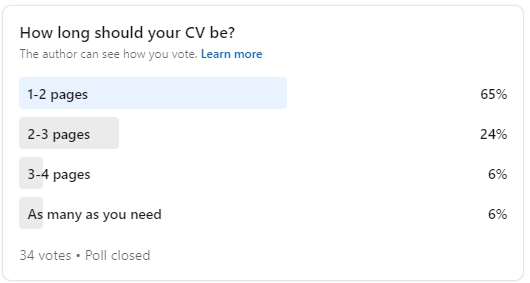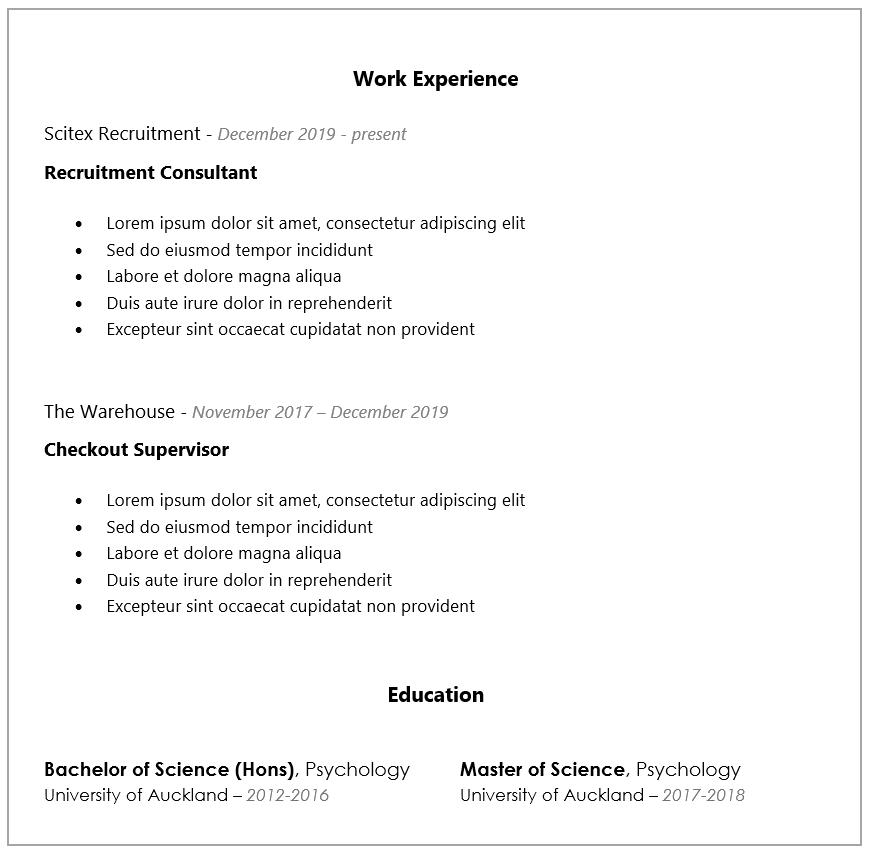How many pages do you think a CV should be? How many pages is your CV?
The ‘optimal’ CV length seems to be of very high interest to job seekers. We recently put a poll up on the Scitex LinkedIn page posing the question: How long should your CV be? The results were as follows:

This is more or less what we expected to see. Interestingly though, we had some of the voters’ CVs on file, and many of the people who chose the 1–2-page option had longer CVs, sometimes up to 4 or 5 pages.
We would have chosen the 2-3-page option. Our perspective is that most job seekers should have a CV around 2-3 pages. Of course, this is just a guideline – if you want a more nuanced and helpful answer, including some tips for amending your CV to a more appropriate length, then keep reading.
Does the length of a CV matter?
Yes, it absolutely does. Though perhaps not as much as you might think. Employers and recruitment agencies aren’t holding you to a strict page limit. The length of a CV matters only so far as it is the appropriate length to convey the necessary information in a way that is clear and accessible for the reader.
I am not here to prescribe a correct CV length for different career stages, industries, or vocations. Instead, the goal is to give you the knowledge and tools to understand how the length of a CV can impact its effectiveness, as well as how to improve your CV to bring it to an appropriate length.
In a previous blog I wrote: “your CV should be just as long as necessary to communicate your skills and experience to the reader”. Rather than aiming for a pre-determined page length, you should keep in mind the general principles of writing a good CV and let the pages end up where they are.
The purpose of a CV
One of the key things I come back to whenever I give CV writing advice is to recall the actual purpose of a CV. First and foremost, your CV needs to persuade the recruiter or hiring manager to pick up the phone and call you. It is very rare that a recruiter will read an entire CV. A 5- or 10-minute chat is a lot more valuable to us than the same amount of time reading a CV.
Most of the time we are looking for a handful of key skills/non-negotiables. If you are in the right ballpark, we’ll call you to have chat. Therefore, you want to make sure your CV includes everything that a recruiter might be looking for, but importantly, not contain so much detail that the important pieces are lost amongst a mass of less relevant information. You don’t need to write a full treatise of your professional life; you just need enough of an overview and a few key details to interest the recruiter.
Content
At a minimum, your CV should contain the following:
- Your name & contact details
- Your work experience
- Your education (if relevant)
You may also want to include a personal statement, a separate list of skills, some personal interests/hobbies, key projects, volunteering experience, publications, and the list goes on… The actual content of your CV is going to depend on your background and on the role for which you are applying.
The most common issue with an overlong CV is having too much detail in your work experience section. Be deliberate with what you are including in your CV; don’t just include a list of every minor task you were somewhat involved with, instead talk about your primary responsibilities without being too granular. A decent rule of thumb is that each past role should take not much more than a third or maybe half of a page.
Tip: most experienced recruiters will be able to get a decent idea of your responsibilities by looking at your job title and employer. You don’t need to be too specific.
Structure and Formatting
You want to present your CV in a way that makes it easy to navigate and read. That means having clearly identifiable sections and sub-sections. The best way to do this is by strategically using different font sizes as well as boldened and italicised text for your headings and sub-headings. The reader should very quickly be able to find different parts of your CV, and you do this by having varied but consistent formatting across the different headings and subheadings.
For example:

You can be fairly creative with how you format and structure your CV, but you still want to conform to a fairly typical general layout. For more information on the structure of your CV, check out Resume Writing 101.
One-page CVs
For many people, one page is a great length for their CV. The obvious case is for school leavers or recent graduates who likely don’t have much or any work experience. If this is your situation, you want to flesh out your education more than you typically would – include some information about which subjects you focused on, what your strengths were, and any extra-curricular pursuits you were involved with. On the other hand, if you’ve been in the workforce for a few years, you could probably do with more than a single page.
However, please don’t think that you must have a longer CV if you aren’t a recent graduate. Sometimes more senior people can get away with single page CVs too.
Two- or three-page CVs
As I’ve said, this is a good ballpark for most people to aim for. There is enough space to expand upon your most recent few roles, to present your content in a clear and parsable manner, and to briefly include less relevant past jobs and some of the other CV elements (personal summary, technical skills, volunteering, etc.) that can add weight to your application.
Four-page CVs & longer
It is rare that I see a 4- or 5-page CV where the length is necessary. Sometimes there really isn’t that much content, but it is formatted terribly with excessive white space, a massive font size, or filled with excessive amounts of unnecessary graphics/design elements. Other times there is simply way too much detail. Recruiters are busy and are unlikely to read your entire CV, especially if it is 4+ pages and full of fluff.
You want to be concise and to the point so that your key achievements and most relevant skills are front, centre, and easily identifiable, rather than lost in the marshes of extra detail. Expand on your most recent 2-3 roles (or the roles most relevant to the job you’re applying to) and include much briefer descriptions of the rest of your career.
Editing your CV to an appropriate length
Tailor Your CV to the Job
Striking the balance between brevity and too much detail can be tough. For that reason, one of the most important things you can do when applying for jobs is to carefully read the job advertisement (or the job description if you have one) and customise your CV to fit that specific role.
It may sound like a lot of work to update your CV for every role you are applying to, but if most of the roles are relatively similar, you won’t need to make many changes. Look out for the key requirements and make sure those are clearly identifiable throughout your CV. This is where brevity can help a lot – by having less fluff, the more relevant aspects of your experience will be more identifiable and salient.
A little hint: most of the time, experienced recruiters will be able to get a decent idea of your responsibilities by looking at your job title and employer.
Don’t Squeeze Your CV into One or Two Pages
One of the themes I hope you’ve picked up by now is that you want to make it easy for the reader of your CV to find the relevant and important information. With that in mind, it is a very bad idea to cram a whole lot of information into a dense two pages just because you have read somewhere that your CV needs to be two pages.
If your CV is too dense you should look back over your content and decide if there is any irrelevant or superfluous information which you could remove (keeping in mind the principles mentioned above). On the other hand, if all of the content is important, simply format it better. Spread it out, use more white space, and present the content over an extra page. This will make the reader’s experience a whole lot nicer, and the relevant information will be easier to parse, and more likely to be seen.
Notable exceptions:
Academics
If you’re an academic, you will likely have quite a long CV, mostly due to your list of conference appearances, publications, research, and projects, etc. When you are applying for academic roles, great, keep your CV as it is. However, if you are applying to non-academic roles, you should create another CV where the academic elements are toned down.
Portfolio CVs
We see very few CVs from artists, photographers, fashion designers, or other creatives here at Scitex. Most of the advice above may not apply to you. If including a portfolio of your work is standard in your industry, your CV will also likely be longer than 2-3 pages. Alternatively, you could present a more standard CV, and include your portfolio as supplementary material.
Some key takeaways
- Be conscious of giving the reader room to breathe. If your CV looks more like an essay than a resume, you need to make some changes.
- Be exact with what content you include: expand on your primary responsibilities without being too granular – a recruiter will call you for more information if they are interested.
- Tailor your CV to the job: look for non-negotiables and key skill requirements in the job advertisement and make sure they are obvious, clear, and prioritised in your CV.
- Get rid of the fluff: recruiters aren’t looking for an essay on your career to date. It is a lot more work for you and they won’t read it all anyway.
Also check out these links to some additional information & resources that may help:
NZ Immigration – how to develop an NZ style CV
MoneyHub – CV tips and free CV templates
-Scitex


